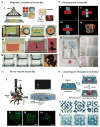Engineering cancer microenvironments for in vitro 3-D tumor models
- PMID: 28458612
- PMCID: PMC5407188
- DOI: 10.1016/j.mattod.2015.05.002
Engineering cancer microenvironments for in vitro 3-D tumor models
Abstract
The natural microenvironment of tumors is composed of extracellular matrix (ECM), blood vasculature, and supporting stromal cells. The physical characteristics of ECM as well as the cellular components play a vital role in controlling cancer cell proliferation, apoptosis, metabolism, and differentiation. To mimic the tumor microenvironment outside the human body for drug testing, two-dimensional (2-D) and murine tumor models are routinely used. Although these conventional approaches are employed in preclinical studies, they still present challenges. For example, murine tumor models are expensive and difficult to adopt for routine drug screening. On the other hand, 2-D in vitro models are simple to perform, but they do not recapitulate natural tumor microenvironment, because they do not capture important three-dimensional (3-D) cell-cell, cell-matrix signaling pathways, and multi-cellular heterogeneous components of the tumor microenvironment such as stromal and immune cells. The three-dimensional (3-D) in vitro tumor models aim to closely mimic cancer microenvironments and have emerged as an alternative to routinely used methods for drug screening. Herein, we review recent advances in 3-D tumor model generation and highlight directions for future applications in drug testing.
Conflict of interest statement
Conflict of interest statement Dr. Utkan Demirci is a founder of, and has an equity interest in: (i) DxNow Inc., a company that is developing microfluidic and imaging technologies for point-of-care diagnostic solutions, and (ii) Koek Biotech, a company that is developing microfluidic IVF technologies for clinical solutions. Dr. Utkan Demirci’s interests were viewed and managed in accordance with their conflict of interest policies.
Figures








References
-
- Asghar W, et al. Cancer Targeted Drug Delivery. Springer; 2013. In vitro three-dimensional cancer culture models; p. 635.
-
- Krausz E, et al. J Biomol Screen. 2013;18(1):54. - PubMed
Grants and funding
LinkOut - more resources
Full Text Sources
Other Literature Sources
